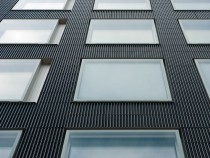
© Frank Kaltenbach
In designs for facades of residential buildings in city centres, conflicts of interest often arise. On the one hand, the residents want an adjoining outdoor space, and, with the prospect of greater demand and higher prices per square metre, it is in the investors’ interest to fulfil this desire. On the other hand, the cantilevers and cut-outs accompanying balconies and loggias disrupt the homogeneous appearance of the facade and the urban character of the city. In particular, most recently, with the increased popularity of residential high-rises, the question has arisen how to make generously dimensioned outdoor spaces available to the residents that can also be used when there are strong winds, inclement weather, or low temperatures.
This past May in Zurich’s centre a new building complex including a 70 m high residential tower with punctuated facade was completed in which some of the windows can be completely opened, yet do not obstruct the living space. Such large-format turn-and-tilt-lift windows are electrically operated and open the living space toward the outdoors; they were employed in the residential tower “Löwenbräu Black” and give its occupants a spectacular view of the Swiss metropolis. The turn-and-tilt-lift window contributes to the perception of spaciousness, because all of the profiles are hidden from view.
The residential tower, clad in black undulating glazed ceramic, is part of a composition made up of a number of buildings that, each with an essence of its own, render visible the different functions present on the grounds of the former Löwenbräu brewery. It stands in contrast to the four-storey museum wing in exposed concrete that is now home to two art institutions: “Kunsthalle Zürich” and the “Migros Museum für Gegenwartskunst”.
The high-gloss red ceramic tiles of the nine-storey office building pick up on the chromacity of the listed brick buildings on the grounds, yet, at the same time differs from their matt brick facades.
Josef Gartner was commissioned to develop and execute the facade. Following firing, the tiles used for the 3900 m2 ceramic facade were completely glazed – including the edges and seams. The 577 windows, with a combined surface area of 3800 m2, are multi-paned windows with vertical vents on the left or right of the glass sashes. These 120 mm wide vents can be opened 90 degrees, and can be used for direct ventilation. Accordingly, it was possible to do without air conditioning. (Klaus Lother, Frank Kaltenbach)
This past May in Zurich’s centre a new building complex including a 70 m high residential tower with punctuated facade was completed in which some of the windows can be completely opened, yet do not obstruct the living space. Such large-format turn-and-tilt-lift windows are electrically operated and open the living space toward the outdoors; they were employed in the residential tower “Löwenbräu Black” and give its occupants a spectacular view of the Swiss metropolis. The turn-and-tilt-lift window contributes to the perception of spaciousness, because all of the profiles are hidden from view.
The residential tower, clad in black undulating glazed ceramic, is part of a composition made up of a number of buildings that, each with an essence of its own, render visible the different functions present on the grounds of the former Löwenbräu brewery. It stands in contrast to the four-storey museum wing in exposed concrete that is now home to two art institutions: “Kunsthalle Zürich” and the “Migros Museum für Gegenwartskunst”.
The high-gloss red ceramic tiles of the nine-storey office building pick up on the chromacity of the listed brick buildings on the grounds, yet, at the same time differs from their matt brick facades.
Josef Gartner was commissioned to develop and execute the facade. Following firing, the tiles used for the 3900 m2 ceramic facade were completely glazed – including the edges and seams. The 577 windows, with a combined surface area of 3800 m2, are multi-paned windows with vertical vents on the left or right of the glass sashes. These 120 mm wide vents can be opened 90 degrees, and can be used for direct ventilation. Accordingly, it was possible to do without air conditioning. (Klaus Lother, Frank Kaltenbach)







